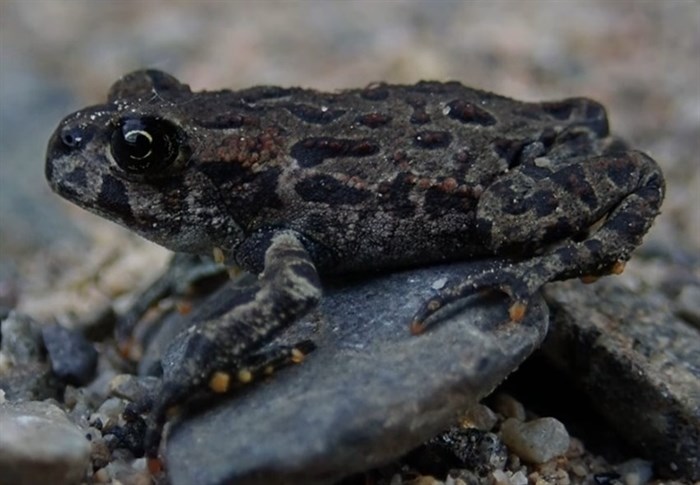
A western painted toadlet was one of thousands hopping around Lambly Lake in West Kelowna on July 26, 20205.
Image Credit: YOUTUBE
August 05, 2025 - 4:00 AM
Kelowna resident Chris Klugh was careful where to step when walking through hordes of tiny western toadlets at a lake in West Kelowna last week.
The nature lover was with a friend at Lambly Lake, a popular fishing and camping site on Bear Lake main road.
“They (toadlets) were all over everything, including the rocks,” he said. “There were tens of thousands of them, if not hundreds of thousands all lined up along the edge of the lake but not in it. I couldn’t tell if the whole lake was like this or just where we happened to be.”
Klugh took a video of the toadlets showing the chaotic phenomenon along with his efforts to not squish them, before he left the area to avoid hurting them.
iNFOnews.ca sent Klugh’s video to BC naturalist Frank Ritcey who confirmed the species.
While western toadlets are seen in huge numbers this time of year at various lakes in the Thompson-Okanagan, the little critters are a species of conservation concern in BC due mostly to habitat loss, according to the provincial government. They also have naturally low survival rates.
Every spring the adult toads migrate to breeding ponds where females lay an average of 12,000 eggs each, but more than 99% won’t survive to adulthood.
The eggs hatch into tadpoles that turn into toadlets which emerge from the water to find terrestrial habitats such as forests and grasslands. Western Toad tadpoles are vulnerable to birds, fishes and predaceous insect larvae, and the toadlets are snacks for many animals including garter snakes, birds and other amphibians.
Western toads spend winter burrowed below the frostline, up to 1.3 metres underground, and every few years, adult toads return to the same pond to start the process all over again.
“My friend said it’s normal for this lake at this time of year and a camper said something about it being quite noisy at night,” Klugh said.
Population declines of the toads are suspected in the southwestern part of the province in part due to development in and around wetlands and migrating toads getting killed by traffic on roads.
To contact a reporter for this story, email Shannon Ainslie or call 250-819-6089 or email the editor. You can also submit photos, videos or news tips to the newsroom and be entered to win a monthly prize draw.
We welcome your comments and opinions on our stories but play nice. We won't censor or delete comments unless they contain off-topic statements or links, unnecessary vulgarity, false facts, spam or obviously fake profiles. If you have any concerns about what you see in comments, email the editor in the link above. SUBSCRIBE to our awesome newsletter here.
News from © iNFOnews, 2025